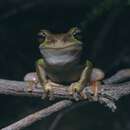Distribution and Habitat
(
İngilizce
)
AmphibiaWeb articles tarafından sağlandı
Along the coast of New South Wales and Victoria. From mid-eastern New South Wales to eastern Victoria.The extent of occurrence of the species is approximately 68000 km2
- Anstis, M. and Littlejohn, M.J. (1996). ''The breeding biology of Litoria subglandulosa and L. citropa (Anura: Hylidae), and a re-evaluation of their geographic distribution.'' Transactions of the Royal Society of South Australia, 120, 83-99.
- Hero, J.-M., Littlejohn, M., and Marantelli, G. (1991). Frogwatch Field Guide to Victorian Frogs. Department of Conservation and Environment, Victoria.
- Tyler, M.J. and Anstis, M. (1975). ''Taxonomy and biology of frogs of the Litoria citropa complex (Anura: Hylidae).'' Records of the South Australian Museum , 17(5), 41-50.
Life History, Abundance, Activity, and Special Behaviors
(
İngilizce
)
AmphibiaWeb articles tarafından sağlandı
Rarely seen. Wet or dry forest, temperate rainforest and woodland. Preferred habitat is rocky flowing streams in heavily forested areas. Often hides under rocks along streams. Restricted to streams with intact riparian vegetation.Breeding occurs in spring (September and October). Males call from a variety of positions, including from rocks and low vegetation within a few metres of shallow slow-flowing water. About 650-900 eggs are laid and sink to the bottom where they adhere to rocks in pools and backwaters of streams.
Life History, Abundance, Activity, and Special Behaviors
(
İngilizce
)
AmphibiaWeb articles tarafından sağlandı
No known declines and extent of occurrence > 20, 000km2.ThreatsLoss of habitat for farming and urbanisation. Disturbances upstream of breeding sites.Conservation MeasuresProtected where it occurs in rainforest or in National Parks.

